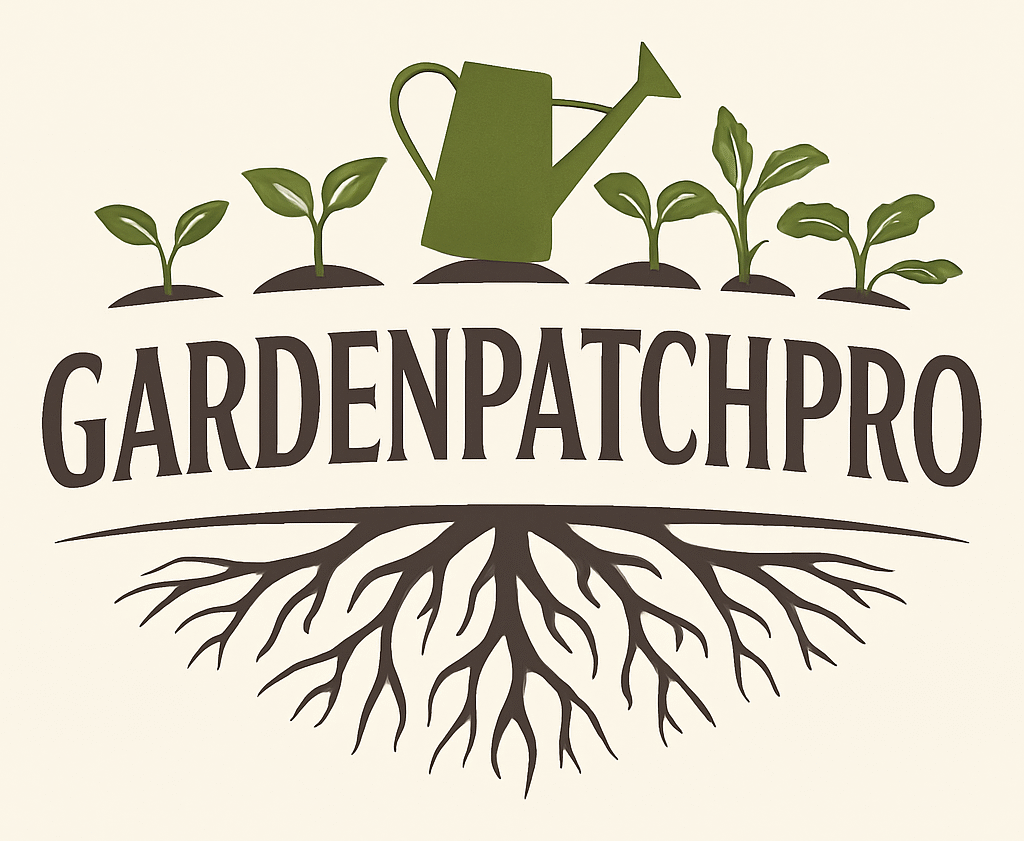14 Cucumber Trellis Ideas to Maximize Garden Space and Yield
Growing cucumbers can take up a lot of space, especially in small gardens. Using a trellis helps keep plants organized and makes harvesting easier. It also allows cucumbers to grow vertically, saving room and improving air circulation.
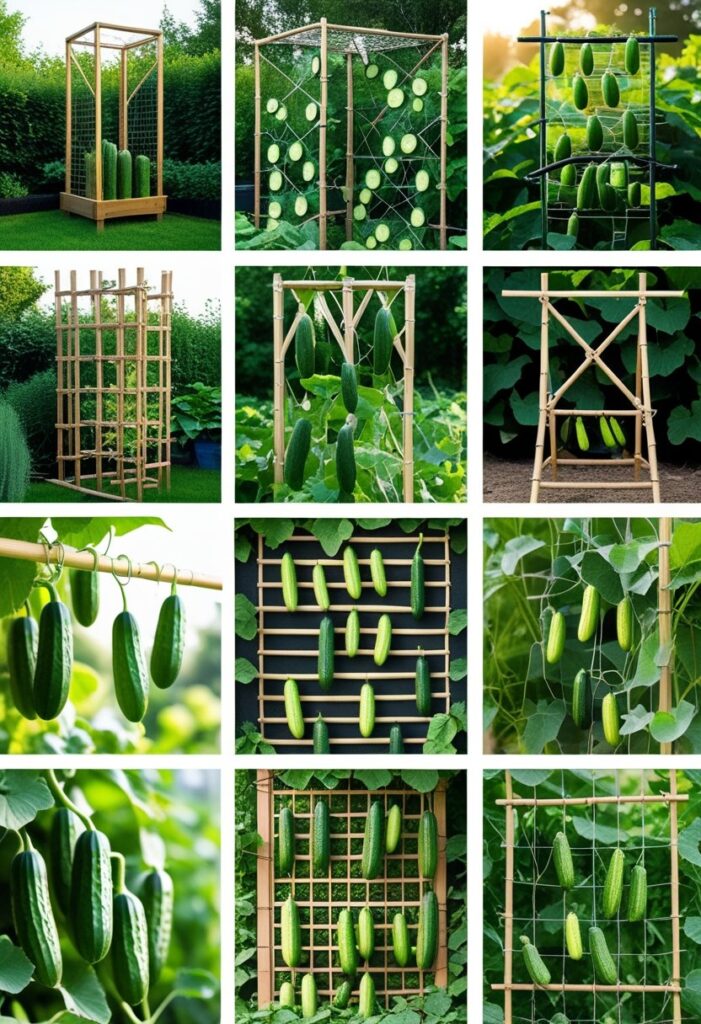
A cucumber trellis supports the plant and maximizes garden space, leading to healthier growth and better yields. There are many ways to build or buy trellises, so gardeners can find options that fit their needs and budgets.
1) Bamboo Frame Trellis

A bamboo frame trellis is a simple and sturdy structure for growing cucumbers. It uses bamboo poles tied together to create a strong frame that supports the plants as they climb.
This type of trellis helps cucumbers grow vertically, saving space in the garden. It also improves air circulation around the plants, which can reduce the risk of disease.
To build it, bamboo poles are set up in a rectangular shape or an A-frame. Strong string or twine is stretched between the poles to give the cucumbers something to grip.
Bamboo is lightweight but durable, making it easy to move or adjust. It is also a natural and eco-friendly material that blends well with garden settings.
A bamboo frame trellis works well in sunny spots, where cucumbers need plenty of light. It is an affordable option that gardeners can build themselves without special tools.
For a detailed guide on making a bamboo trellis, see DIY Guide to Building a Bamboo Trellis for Cucumber Plants.
2) PVC Pipe Arch Trellis
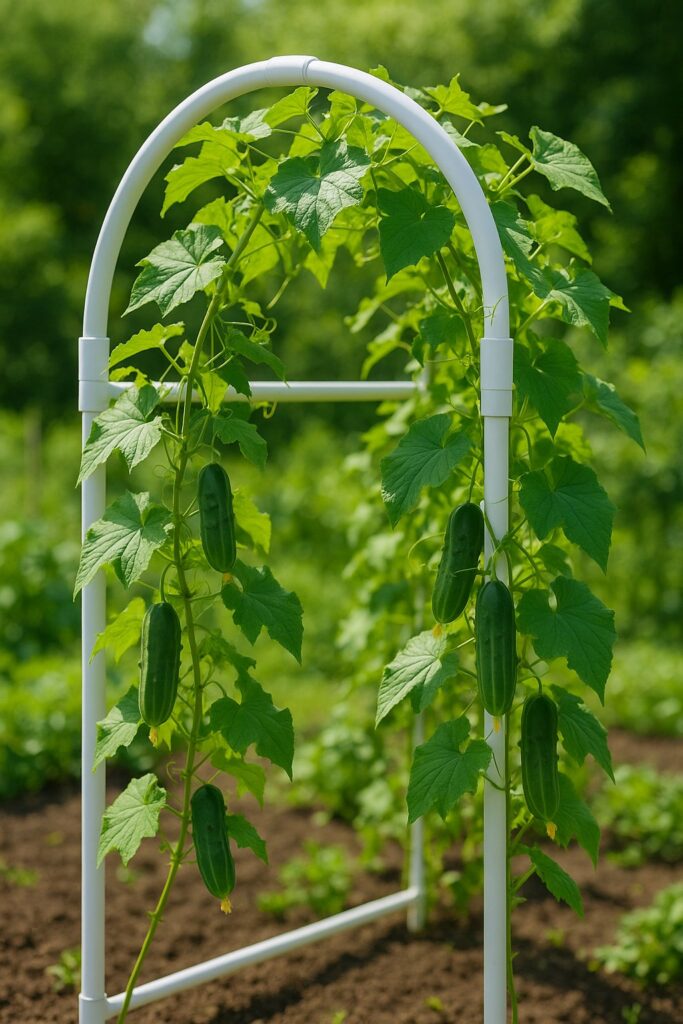
A PVC pipe arch trellis is a simple and durable way to support cucumber vines. The pipes can be bent into an arch shape and secured into the ground, creating a tall structure for plants to climb.
This trellis type is weather-resistant and lightweight. It allows cucumbers to grow upward, saving garden space and improving air circulation around the plants.
To build it, a gardener will need several lengths of PVC pipe, connectors, and stakes to anchor the frame. The design can be adjusted to fit different garden sizes.
The arch shape is strong enough to hold the weight of growing cucumbers. It also makes it easier to harvest the fruit without bending or reaching awkwardly.
Using PVC pipe for a trellis is a practical choice because the materials are affordable and easy to work with. It requires no special skills to assemble and can be reused in future seasons.
More detailed ideas on making this trellis can be found with PVC pipe arch trellises for cucumber gardens.
3) Wooden Lattice Panel
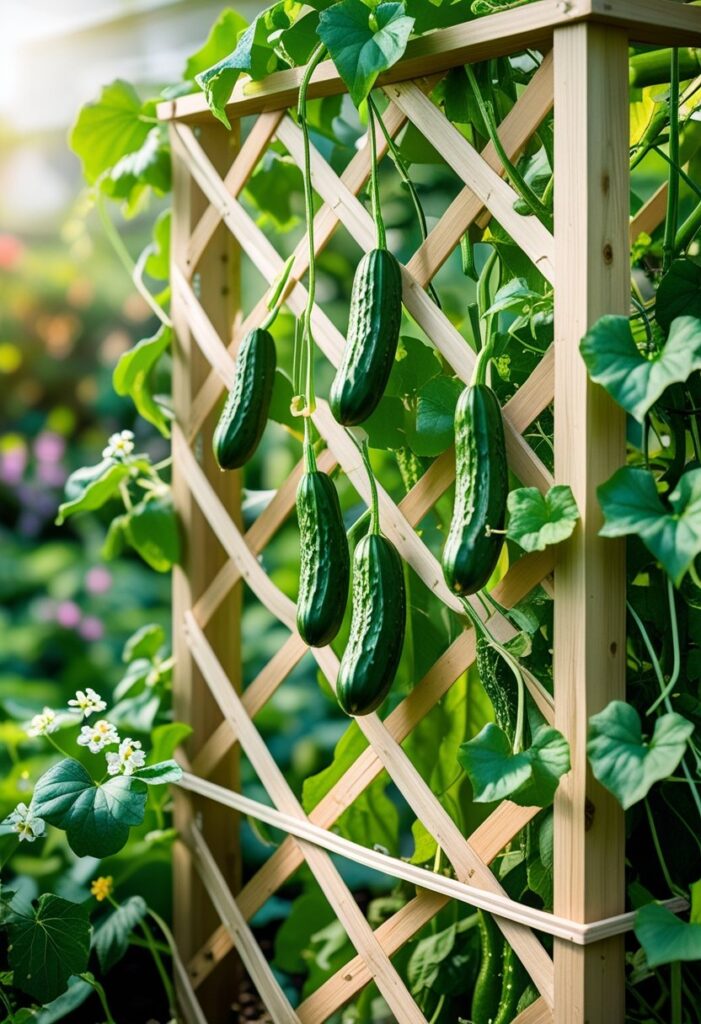
A wooden lattice panel offers a simple and effective way to grow cucumbers vertically. It provides a sturdy framework for cucumber vines to climb, which helps save space in the garden.
The spacing in the lattice allows good air flow around the plants. This can reduce mildew and other fungal problems on the leaves.
Wooden lattice panels come in different sizes. Gardeners can choose one that fits their garden space and height needs.
They can also be bought pre-made or built by hand using wood slats. This flexibility makes it easy to customize for any garden style.
Using a wooden lattice panel makes harvesting easier. The cucumbers hang visibly, making it simple to spot ripe fruits.
This type of trellis is durable and can last for several growing seasons if properly maintained. It is a practical choice for gardeners looking to maximize their cucumber harvest using vertical space.
More ideas on wooden lattice trellises can be found at MrPlanter’s cucumber trellis ideas.
4) Rebar Arch Trellis
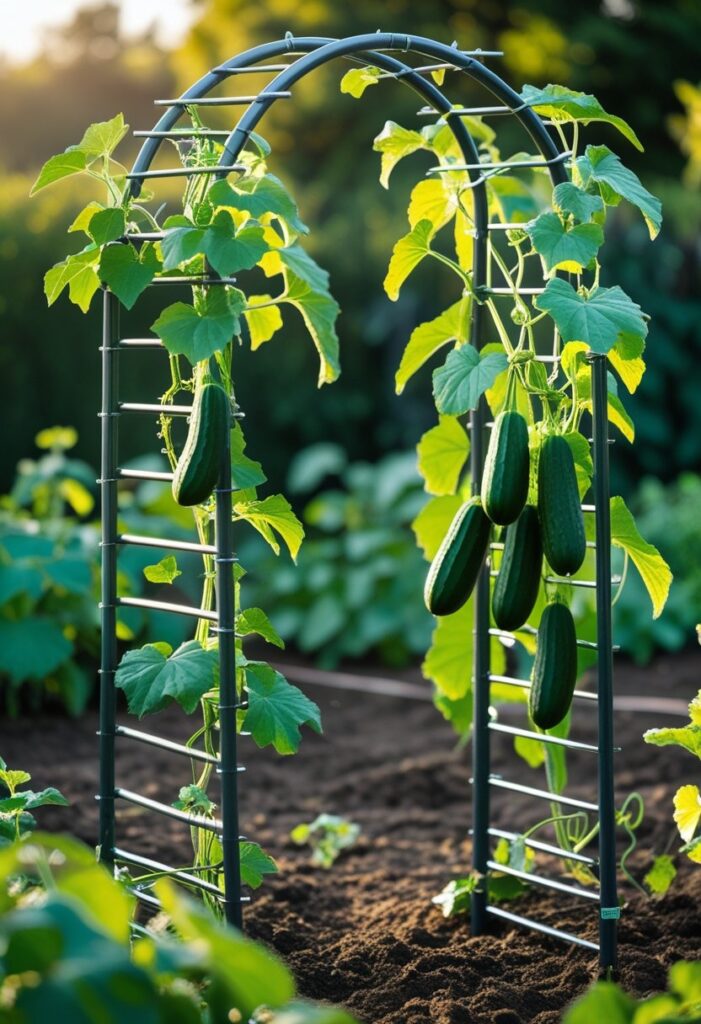
A rebar arch trellis uses strong steel rods bent into a curved shape. This design is sturdy and can support heavy cucumber vines well. It works in small or large gardens and adds height for better air circulation around the plants.
The arch shape saves space by allowing cucumbers to grow vertically and on both sides. It also creates a shaded area underneath that can be used for walking or planting shade-loving plants. The slim profile of rebar means the trellis won’t block much sunlight.
To build this trellis, rebar stakes are placed into the ground on both sides. Then, metal fencing or wire panels are bent over the stakes to form the arch. The pieces are secured tightly with zip ties or wire. This setup holds up well in wind and heavy loads.
The rebar arch trellis can be made with simple tools and materials found at most hardware stores. Its durability and flexibility make it a popular choice for gardeners who want a long-lasting support structure for cucumbers. For more ideas, see the detailed examples of rebar trellis designs.
More about sturdy cucumber trellis builds is available at 17 Creative DIY Cucumber Trellis Projects to Transform Your Garden.
5) Tiered Wooden Trellis System
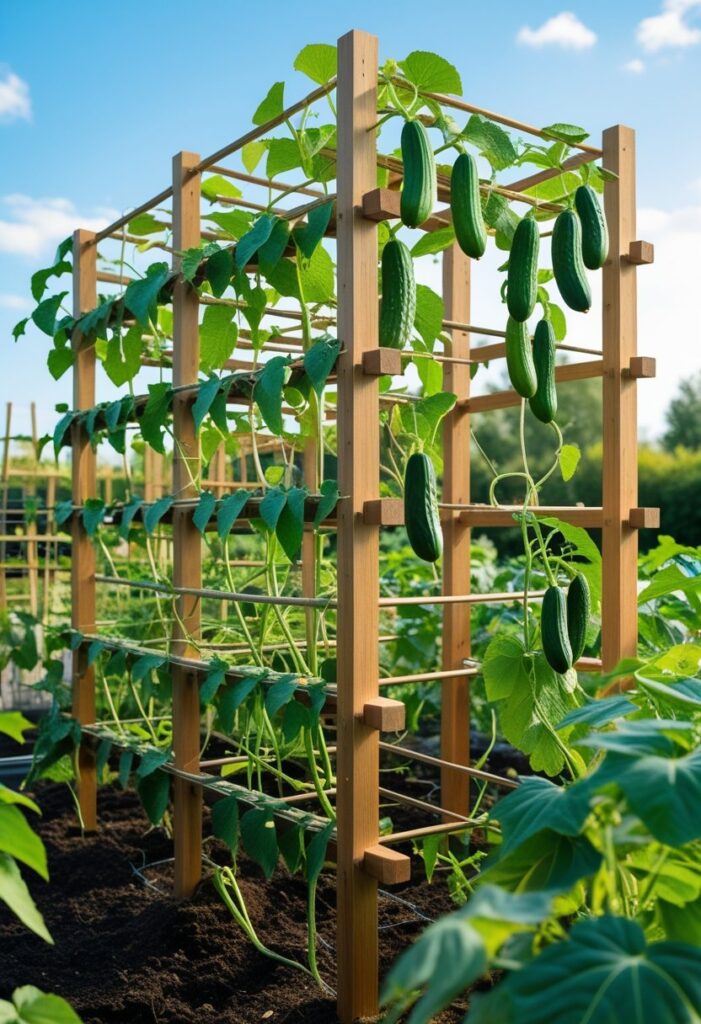
A tiered wooden trellis system uses multiple levels of wood frames stacked vertically. This design helps gardeners grow more cucumbers in a small area by using the vertical space efficiently. It fits well in small gardens or containers.
The wood provides strong support for cucumber vines as they climb upwards. Better air circulation occurs between levels, which can reduce the risk of mold and pests. It also helps sunlight reach more parts of the plant.
Building a tiered trellis can involve simple wood pieces nailed or screwed together. It is sturdy and lasts through the growing season. This system is practical for anyone wanting to maximize space without complicated setups.
A tiered wooden trellis system encourages healthy vine growth and can make harvesting easier. For more ideas on layered vertical growing, see tiered trellis designs for cucumbers.
6) Garden Pallet Trellis
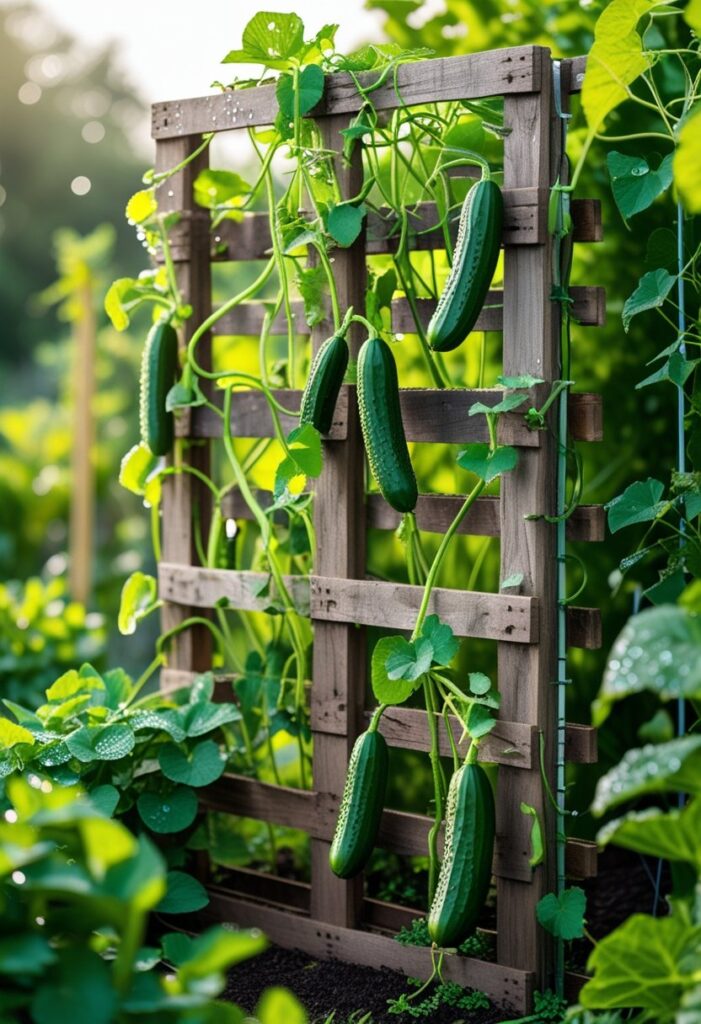
A garden pallet trellis is a simple and cost-effective option for growing cucumbers. It uses an old wooden pallet standing upright to support the cucumber vines as they climb. This keeps the cucumbers off the ground, reducing the chance of pests and rot.
The pallet’s open slats provide natural spaces for the vines to grip. It can be leaned against a fence or secured with stakes for stability. This makes it easy to set up in small or large garden spaces.
Using a pallet trellis also helps save space by encouraging vertical growth. It improves air circulation around the plants, which can reduce disease problems. Gardeners can repurpose pallets, making it an eco-friendly choice.
For those interested in more ideas about this type of trellis, they can find examples of DIY pallet trellis projects to guide their setup and design on sites like 1millionideas.com.
7) Twig and Branch Trellis
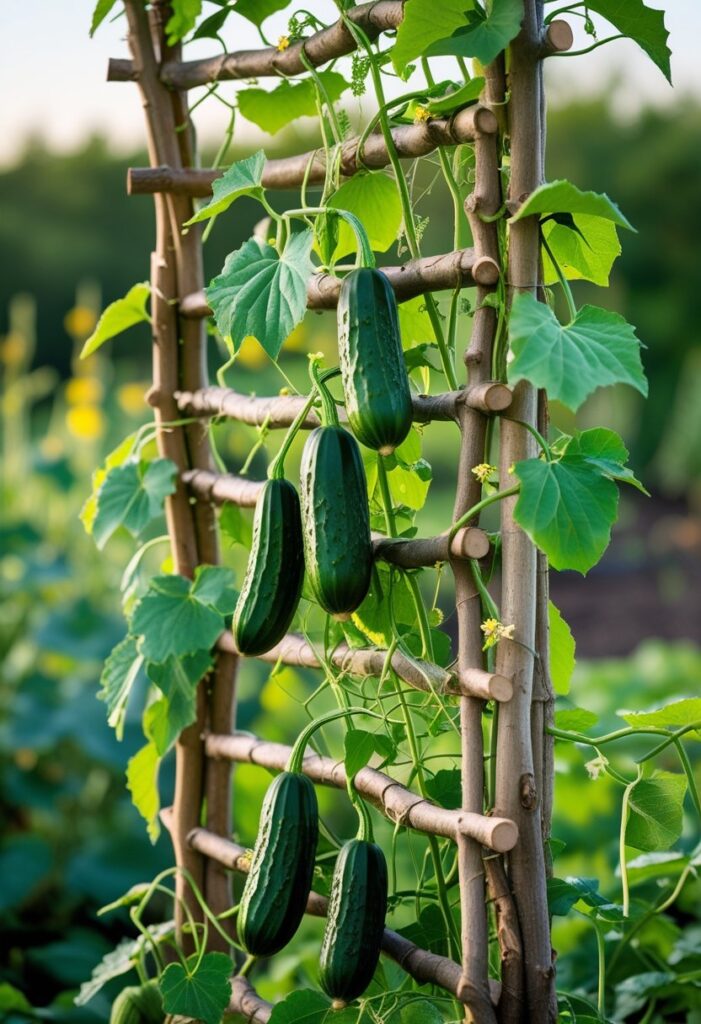
A twig and branch trellis uses natural materials like pruned wood, twigs, or tree branches to support cucumber vines. This type of trellis is simple to build and blends well with garden settings that focus on organic or rustic styles.
The structure can be made by weaving branches together or by tying twigs to create a frame. It provides a sturdy support system that helps cucumbers grow upward, improving air circulation and sunlight exposure.
Because the materials are often collected from around the yard or local areas, this trellis is budget-friendly. It also allows gardeners to recycle natural waste, making it an eco-friendly option.
This design is well-suited for small to medium gardens and encourages healthier plant growth by keeping cucumbers off the ground. For examples and construction ideas, see twig and branch trellis options at 24 Cucumber Trellis Ideas for Outdoors and Landscaping.
8) Metal Tomato Cage Repurpose
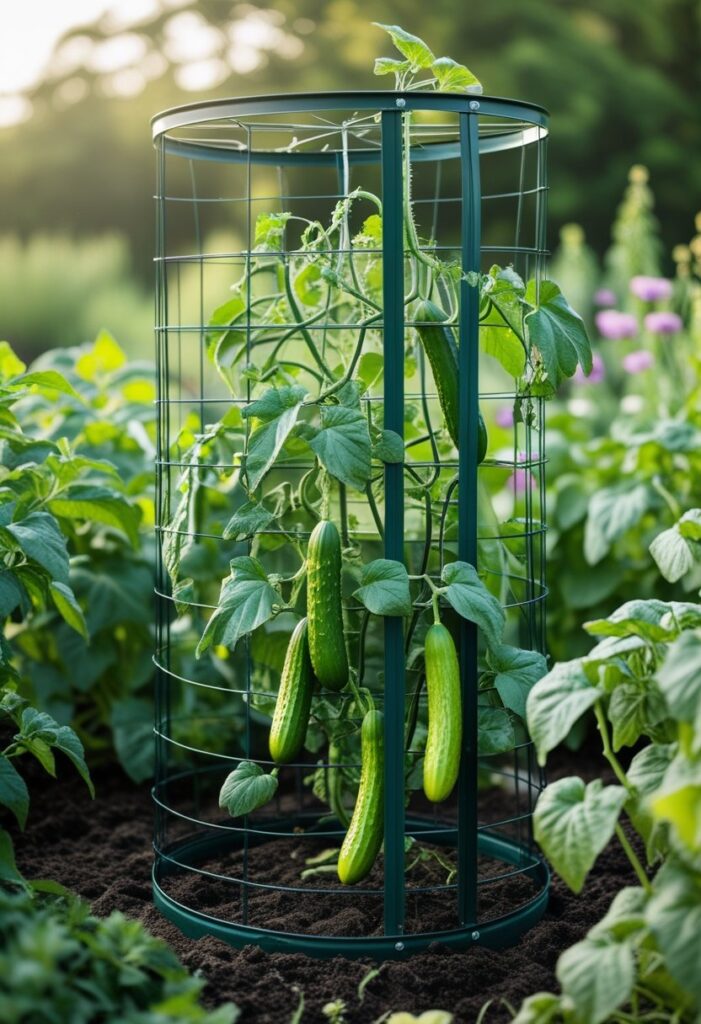
Metal tomato cages work well as cucumber trellises. They provide sturdy support for vines to climb vertically, saving space in the garden.
To use one, simply place the cage over the cucumber plant and push it into the ground. The cucumber vines will weave through the circular wire openings as they grow.
Sometimes, it helps to use two cages together for extra height or stability. They can be secured with zip ties or strong twine if needed.
This method is budget-friendly because it repurposes existing garden tools instead of buying new trellises. Metal cages also hold up well in outdoor weather with minimal wear.
Using a tomato cage as a trellis helps keep cucumbers off the ground. This reduces the risk of rot and pests while encouraging better air flow around the plants.
For more ideas on how to turn tomato cages into cucumber trellises, see this guide on recycled tomato cage trellises.
9) Jute Twine Netting
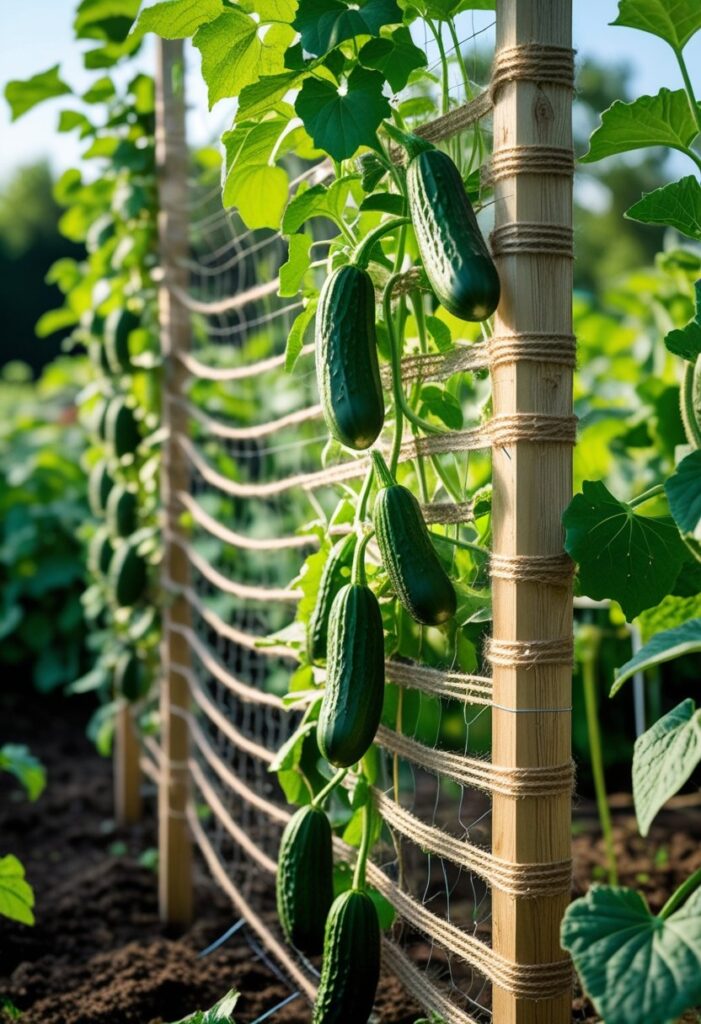
Jute twine netting is a practical option for supporting cucumber plants. It is made from natural fiber that is strong enough to hold the weight of growing vines.
This material is biodegradable, meaning it breaks down harmlessly at the end of the growing season. It offers a balance of durability and eco-friendliness.
To create a jute twine net, one can weave the strings into a grid. The netting provides multiple points for cucumber vines to latch onto as they climb.
Using jute twine also adds a natural look to the garden. It blends well with other plants and does not look out of place among greenery.
Jute netting can support other crops besides cucumbers. It works well for tomatoes, peas, and various climbing vegetables.
Building this type of trellis is simple and budget-friendly. Many gardeners reuse or repurpose jute twine for different seasons.
For detailed steps on making a jute twine trellis net, readers may find this step-by-step guide on jute trellis netting useful.
10) Obelisk Trellis
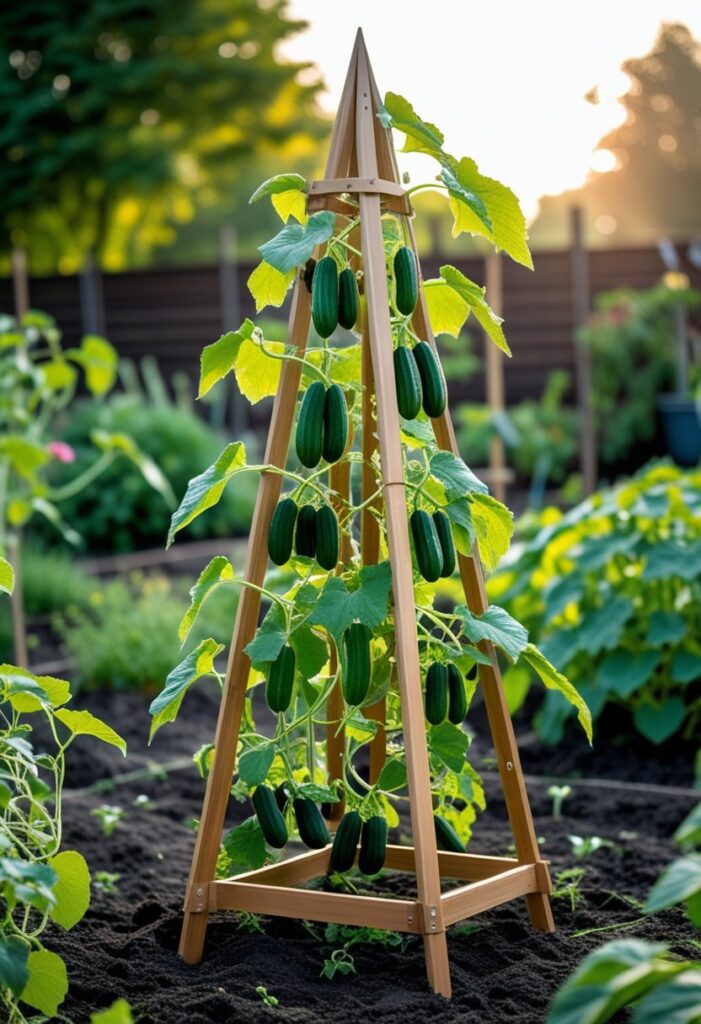
An obelisk trellis is a tall, pyramid-shaped structure. It provides strong vertical support for cucumber vines while taking up very little ground space. This shape helps cucumbers grow upward, improving air flow and sun exposure.
Obelisk trellises can be made from various materials like wood, metal, or PVC pipes. Wood is common because it is sturdy and easy to customize. Metal versions last longer and may withstand weather better.
This trellis style fits well in small gardens, containers, or balconies. It allows gardeners to maximize space without bending over to pick cucumbers. The design also adds a neat, vertical element to the garden’s look.
Building a DIY obelisk can be simple with basic tools. It encourages even growth and keeps cucumbers off the ground, reducing the chance of rot and pests. For more ideas and tips, see this guide on 20 cucumber trellis ideas.
11) Ladder-Style Wooden Trellis

A ladder-style wooden trellis is a practical and classic way to support cucumber vines. It usually consists of two vertical posts with horizontal rungs spaced evenly apart. This design gives cucumbers plenty of room to climb and grow upward.
The horizontal rungs create strong support points for the vines. This helps keep the plants off the ground and reduces the risk of diseases caused by soil contact. It also makes harvesting easier since cucumbers hang in plain view.
Wooden slats for this trellis can often be found at home or at local hardware stores. It can be built quickly with basic tools and nails or screws. The structure is stable and can hold heavy vines well over the growing season.
This trellis suits medium to large garden spaces and can fit well in raised beds or along garden fences. It offers a neat and tidy look that many gardeners appreciate for aesthetic reasons.
For more ideas on ladder-style trellises and other options, see 25 Cucumber Trellis Ideas for a Productive Garden.
12) Wire Mesh Trellis on Frame
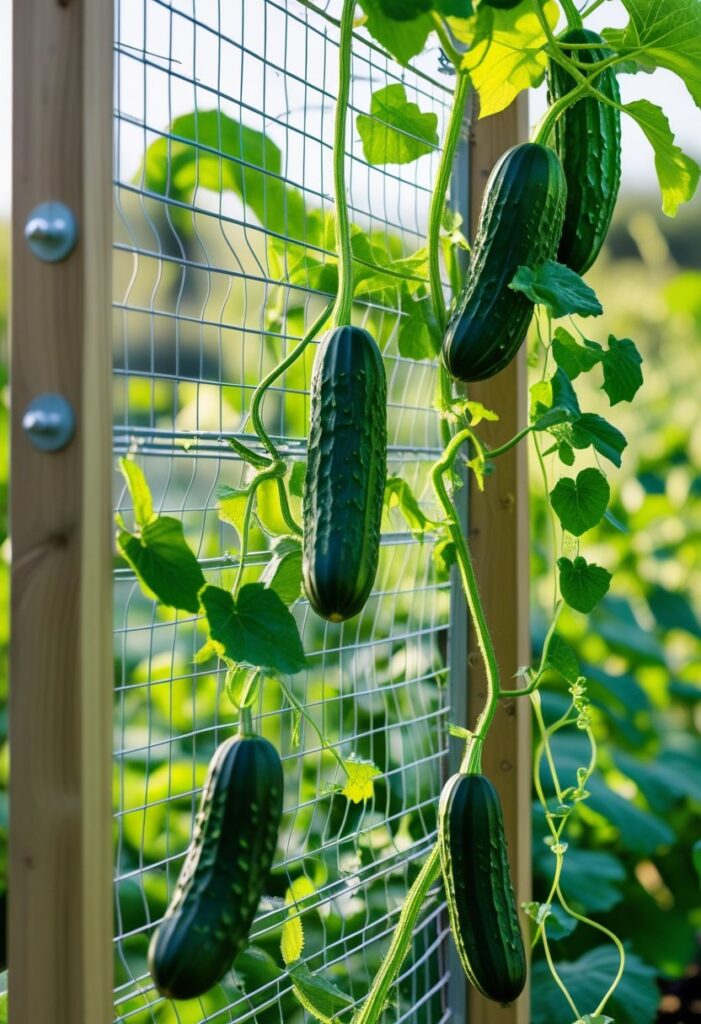
A wire mesh trellis on a sturdy frame is a practical way to grow cucumbers vertically. The frame can be made from wood or metal posts to hold the wire mesh securely.
This design gives strong support for heavy cucumber vines. It allows the plants to climb easily and keeps the fruits off the ground, reducing disease risk.
The wire mesh also lets air and light pass through well, which helps keep the plants healthy. It can be custom-sized to fit small or large garden spaces.
Building a wire mesh trellis is cost-effective and durable. It works especially well for tall cucumber varieties and helps save space by growing upwards.
For a clear guide and detailed ideas on how to build this, see wire mesh trellis examples on The Peasants Daughter or Mr Planter.
13) Tiki Torch Trellis Support
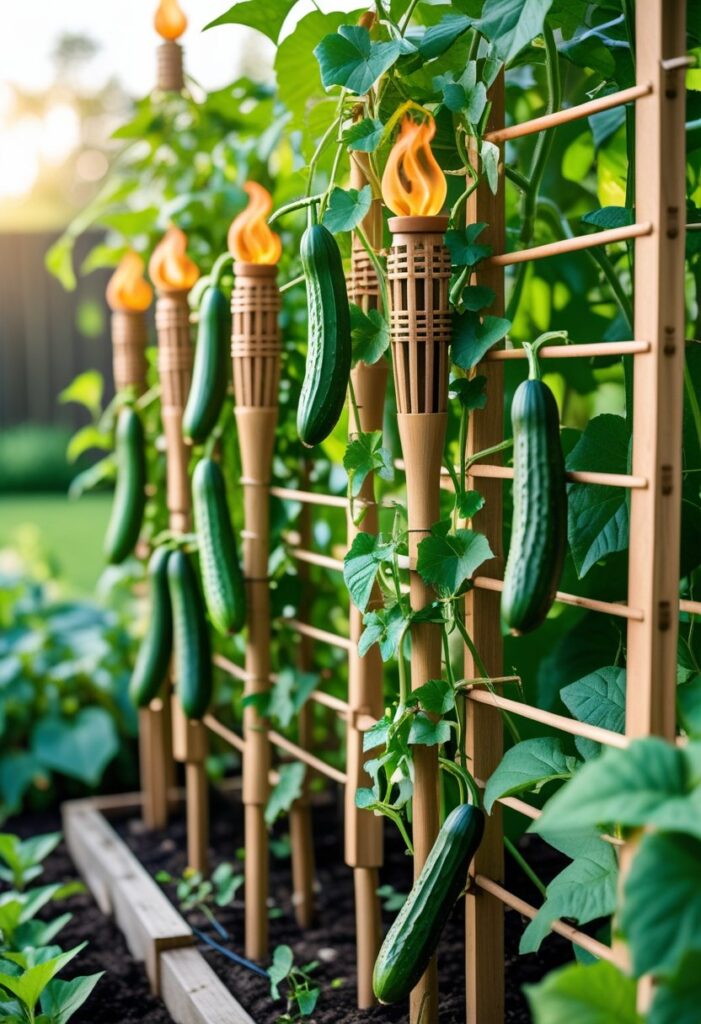
Using old tiki torches as a trellis for cucumbers is a practical way to reuse materials. Their tall and slim shape offers good vertical support for the climbing vines. This helps keep cucumbers off the ground, reducing the risk of rot and pests.
Tiki torches can add a tropical look to the garden. They are sturdy enough to hold the weight of growing cucumber plants as long as they are well-anchored in the soil. The open structure also allows for good air circulation around the vines.
This trellis style works well in small or large garden spaces. It maximizes growing area by encouraging plants to grow upward instead of spreading out. Using tiki torches can be part of a sustainable gardening plan by recycling old garden tools.
For more ideas on using tiki torches as a cucumber trellis, see creative vertical growing options at treevitalize.com.
14) Raised Bed Vertical Trellis
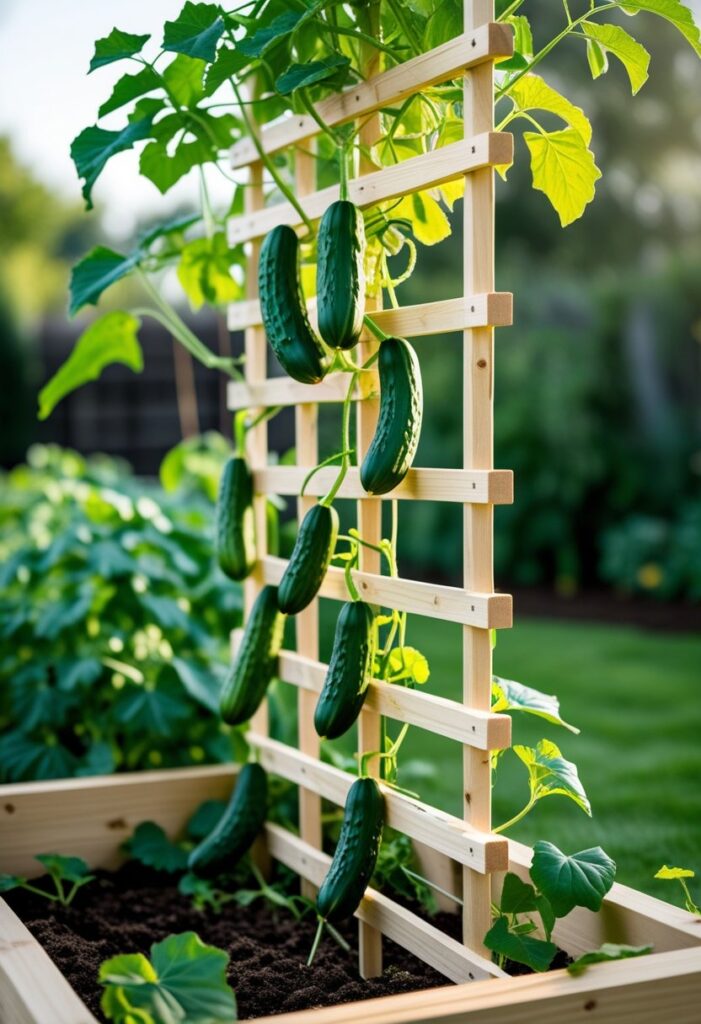
A raised bed vertical trellis uses the height of the bed to support cucumber vines. It involves attaching a trellis frame to the sides or corners of the raised bed. This method saves ground space and keeps the vines off the soil.
The structure is often made by extending the bed’s corner posts upward. These posts hold up a grid or netting for the cucumber plants to climb. This setup allows for better air circulation around the plants.
Using a raised bed vertical trellis can make harvesting easier. It also reduces the chance of cucumbers rotting by keeping them off the damp ground. This style works well in small gardens or where space is limited.
A trellis integrated with a raised bed can be built from wood, metal, or composite materials. It offers a sturdy, long-term solution for growing cucumbers vertically. More details and ideas for this type of design are available at 25 Cucumber Trellis Ideas to Maximize Vertical Space.
Key Factors for Choosing a Cucumber Trellis
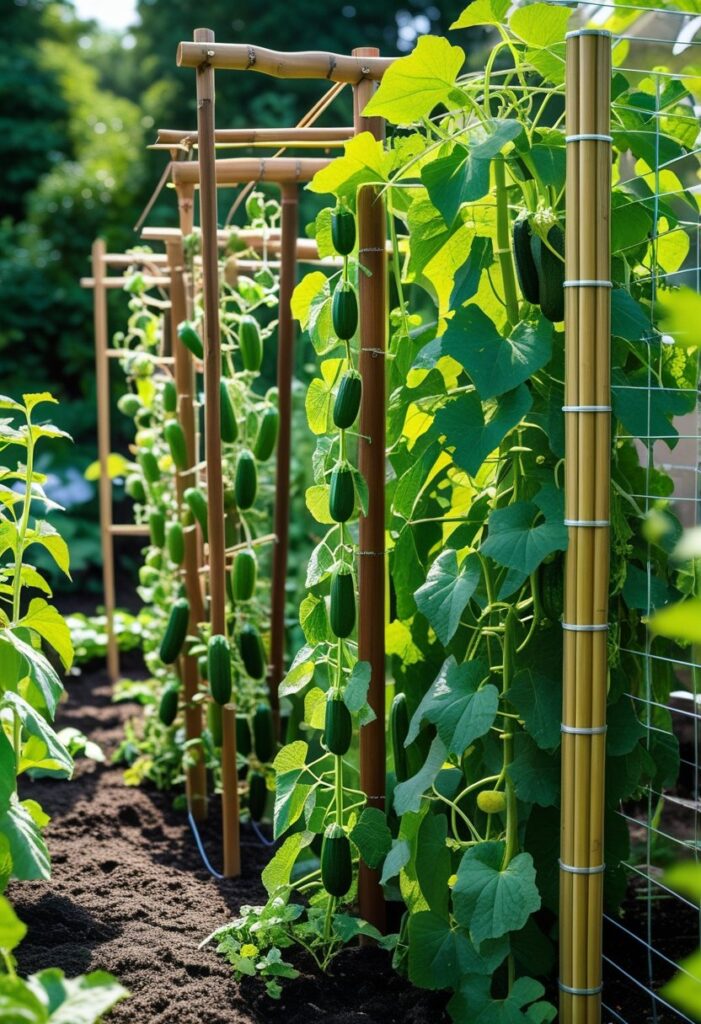
Choosing the right cucumber trellis depends on several important elements. These include how much garden space is available, the strength and type of materials used, and the specific support needs of cucumber plants as they grow. Each of these points affects how well the plant will climb and how much fruit it can produce.
Space Requirements
The amount of space in the garden often determines the size and style of the trellis. Vertical trellises work well in small areas because they lift cucumber vines off the ground, saving room for other plants. For larger gardens, wider or taller trellises can be used to maximize yield.
Raised beds or containers usually call for smaller, more compact structures. In contrast, open garden plots allow for trellises like arched or ladder designs that cover more area.
When planning space, gardeners should also consider access for harvesting and pruning. A trellis should be tall enough to keep cucumbers off the soil but not so high that handling becomes difficult.
Material Durability
Durability is critical because trellises must withstand weather and support the weight of growing plants. Common materials include wood, metal, and bamboo.
Wood is sturdy and easy to work with but may rot over time if untreated. Metal trellises last longer but can be expensive and heavy. Bamboo offers a natural look and is lightweight but is not as strong, making it better for lighter vines or shorter seasons.
Choosing weather-resistant finishes or coatings can extend the life of wooden and metal trellises. Materials should be safe for plants and avoid chemicals that could harm cucumbers.
Plant Support Needs
Cucumbers need strong, reliable support to keep vines healthy and fruits clean. The trellis should allow vines to climb without sagging or breaking.
The design needs to provide enough surface area for tendrils to grip. Mesh, lattices, or wire grids work well for this purpose.
The structure must also be stable to handle strong winds or heavy rain. A well-secured trellis prevents plants from sprawling on the ground, reducing disease risks and making harvesting easier.
Adjustable or modular trellises can help gardeners adapt support as plants grow throughout the season.
Tips for Maximizing Cucumber Growth With Trellises
Proper vine training, correct trellis placement, and regular maintenance all play key roles in growing cucumbers successfully. Paying attention to these details helps improve air flow, reduce disease, and boost fruit production.
Training Vines Effectively
Cucumbers need regular guidance to grow up the trellis. When young vines reach about 6 inches, gently tie them to the trellis using soft plant ties or strips of cloth. Tying prevents vines from sagging and keeps fruit off the ground.
Encourage side shoots to grow along the trellis by weaving them through the structure. This training allows sunlight to reach leaves evenly, which enhances photosynthesis.
Removing weak or diseased runners also focuses energy on stronger vines. Vine training should be checked weekly during the growing season to adjust ties and prevent overcrowding.
Optimal Trellis Placement
Choosing the right location for a trellis is essential. Place it where the plants get at least 6 to 8 hours of direct sunlight every day. Sunlight helps cucumbers grow faster and develop sweeter fruit.
Position the trellis so rows run north to south if possible. This setup maximizes sun exposure.
The trellis should allow good air circulation. Avoid areas close to walls or dense shrubs that block airflow, as poor ventilation raises the risk of mold and mildew.
Ensure the trellis is sturdy enough to hold heavy vines and fruit, especially in windy places.
Maintenance Recommendations
Regular maintenance keeps cucumber plants healthy and productive. Water plants deeply at the base to prevent wetting leaves, which can lead to diseases.
Inspect plants weekly for pests like aphids and cucumber beetles. Early removal or treatment stops infestations from spreading.
Fertilize every 2 to 3 weeks with balanced, water-soluble fertilizer to support steady growth.
Remove old or yellow leaves promptly. This helps prevent fungal problems and directs nutrients to new growth.
Keeping the area around the trellis clean and free of weeds also reduces pest hideouts and disease risks.
For detailed trellis ideas and growing tips, see Cucumber Trellis Ideas and Tips for Maximizing the Harvest.
Frequently Asked Questions
Trellis designs for cucumbers vary by space, material, and style. Builders often choose options that fit small gardens, containers, or raised beds. Durability and ease of construction are key concerns for successful cucumber growing.
What are some compact cucumber trellis designs suitable for small gardens?
Compact designs like bamboo frame trellises and wooden lattice panels save space while supporting vines. These fit well in limited garden areas and allow cucumbers to climb vertically with minimal ground use.
How do you build a sturdy DIY cucumber trellis?
Start with strong framing materials such as PVC pipes or rebar. Secure joints tightly and make sure the trellis is anchored firmly in the soil. For extra support, use cross braces or tiered wooden systems.
Can you recommend cucumber trellis styles that work well in pots?
PVC pipe arch trellises and smaller wooden lattice panels fit well with container gardening. These trellises provide vertical growth without overwhelming the pot’s size or stability.
What are the advantages of using an A-frame trellis for growing cucumbers?
A-frame trellises offer strong support and good airflow around plants. Their shape helps cucumbers get sunlight evenly and makes harvesting easier. They also fold flat for easy storage.
Where can I find affordable cucumber trellises for my raised beds?
Affordable options include repurposed wooden pallets, simple bamboo frames, or DIY kits made from PVC pipes. Many budget-friendly guides show how to make these at home cheaply and effectively. For more ideas, visit this page on cucumber trellis ideas for raised beds.
What materials are most durable for constructing a homemade cucumber trellis?
Metal rebar and treated wood rank high for durability in garden trellises. PVC pipes also hold up well but may need protection from strong winds or heavy plants. Bamboo is sturdy but may degrade faster outdoors.
